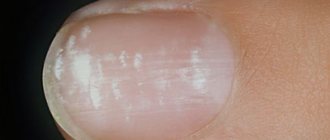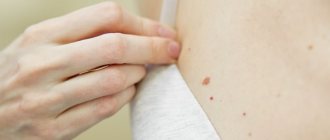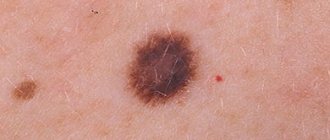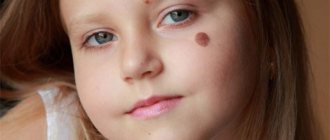Every person has moles, and if they don’t get in the way or are not in visible places, we simply don’t notice them. But it happens that a mole makes itself felt - it hurts, itches, or even falls off. In this case, a trip to a dermatologist is inevitable, because such formations are classified as oncogenic, i.e. capable of developing into cancer.
What is a mole
The content of the article
A mole is a formation on the skin colored by the pigment melanin. The color of the mole can vary, ranging from light to dark brown. Other names for moles are nevus, birthmark. A person can have 30 birthmarks or more. They can be different in shape and size.
Nevi begin to appear from the age of two and continue to gradually form throughout life. Their appearance depends not only on heredity, but also on exposure to ultraviolet radiation and hormonal imbalances in the body for various reasons.
A formation that has not undergone certain changes is considered benign, and in the absence of various types of discomfort does not require consultation with a dermatologist. However, most often moles are harmless and do not pose any threat to human life. However, if the nevus begins to manifest itself, this may be the beginning of a dangerous disease called melanoma.
According to statistics, problematic moles are more common in men than in women. And on the hands the percentage of malignant formations is several times lower than on other areas of the skin.
Diagnostics
Identifying the causes of the appearance of a crust, as well as making a diagnosis, is carried out in several stages:
- Taking an anamnesis - the doctor asks the patient about the conditions under which a crust appeared on the mole, how long this process has been going on and what additional symptoms are accompanied.
- Dermatoscopy - allows you to examine the skin tumor as closely as possible, which helps the doctor determine the diagnosis and possible causes of the development of the pathology.
- Cytological examination of a smear from the surface of a mole - this analysis is most effective if any liquid is released from under the crust. Its sowing makes it possible to detect the presence of pathogenic microflora, and its quantitative and qualitative composition will indicate a possible pathology.
- Histological examination is prescribed if external signs indicate pathological processes in a mole associated with the degeneration of its cells into a malignant tumor. For histology, a section of the mole may be required, but most often it is completely removed, which helps make a more accurate diagnosis and understand whether additional examinations are needed and what therapy is required.
Dermatoscopy is a method for diagnosing a crust on a mole.
If there is a suspicion of the development of cancer, a blood test for tumor markers may be required. This analysis will reveal antibodies in a person’s blood, the appearance of which is characteristic of cancerous tumors.
What is melanoma: dangerous signs of degeneration of moles
Melanoma is a skin tumor that is classified as malignant, in other words, it is skin cancer. A tumor can appear anywhere, but a mole is especially often the source of cancer.
You should urgently see a dermatologist if:
- The mole has changed. For example, it turned black or began to grow;
- It falls off piece by piece and is crushed;
- It is found in places where underwear touches, a belt, or rubs with clothing, and therefore itching and redness of the area around the mole appears.
If a mole falls off on your body, do not ignore this symptom - see a dermatologist as soon as possible.
Why does melanoma occur?
The exact causes of melanoma are still unknown. The main risk factor is prolonged exposure to ultraviolet radiation. To reduce your risk of skin cancer, you need to reduce your time in the sun. Although completely avoiding this does not provide 100% protection against melanoma. Dermatologists advise limiting your stay during dangerous hours - from 11 to 16 hours of the day, and also the time - no more than 30 minutes (if longer, you need to apply protective products with SPF50+).
Visiting a solarium also increases the risk of developing melanoma. According to research, in young people under 35 years of age, artificial tanning can increase the likelihood of skin cancer by 75%. In terms of the risk of developing melanoma, tanning beds are on the same level as smoking as a cause of lung cancer.
Moles as a reason
In 50% of cases, cancer forms from existing moles. The more there are, the higher the risk of encountering melanoma. The process can be triggered by injury, frequent exposure to ultraviolet radiation, or changes in hormonal balance. For this reason, it is necessary to periodically examine moles for any changes. Suspicion should be raised by:
- active growth for a couple of weeks or months;
- changes in color, shape or borders;
- the appearance of small moles and spots nearby;
- the appearance of blood from a mole for no reason;
- crusts, ulcerations;
- pain and itching in the mole area.
Risk factors (who is at risk)
About 10% of people with melanoma have a family history of melanoma. According to research, if two or more close relatives have experienced skin cancer, the likelihood of developing it increases significantly. People at risk include:
- with pale skin that is difficult to tan;
- a lot of freckles;
- red or blond hair;
- blue eyes;
- burn scars;
- diseases of the immune system (HIV);
- exposed to chemicals.
Why do moles fall off?
First you need to find out whether it was a mole. Perhaps it was another formation: age spots, crusts due to injuries, in places of scratching, fungal infections, etc. can form on the skin. Since not every nevus is convex, a mole cannot fall off on its own, because the formation is part of the skin. Formations on the skin that tend to fall off are called keratomas. They are darker than nevi. The older the person, the greater the likelihood that the keratoma will fall off. But if it turns out that it is the mole that has fallen off, then you need to identify the reasons:
- Hormonal surges.
When hormonal imbalance occurs, a mole forms. When it normalizes, the mole dies. Such phenomena are not uncommon during age transitions, during pregnancy, or when taking hormonal medications. - Traumatic factors.
Excessive tanning in direct sunlight, cuts to the mole, or friction of clothing against the nevus can cause the mole to peel off. - Necrosis.
The formation will fall off if it does not receive the substances necessary for normal functioning. For example, long moles are at risk: they become twisted, blood flow is disrupted and the nevus dries out. - Tumor.
The mole causes discomfort, itches and develops into melanoma. Cellular growth occurs, the mole dries out and falls off. This is the most dangerous reason.
Can the crust fall off on its own?
First of all, you will need to determine whether the formation is a nevus. A natural process in older people is the formation of keratoma. This occurs when cell division is disrupted, which leads to keratinization of the dermis.
It happens that a mole disappears along with the crust. This happens for the following reasons:
- with prolonged exposure to UV rays, regular contact with synthetics, and injury;
- under thermal influence;
- the proper amount of nutrients is not supplied;
- the mole has a hanging nature and can twist at the base, blocking the access to blood, as a result of which the formation dries out and falls;
- a new spot appears if hormonal levels are disrupted, and when it returns to normal, the spot dies;
- The nevus is malignant in nature, begins to peel off, itch, and become covered with a crust, which eventually falls off. This may mean that the formation has degenerated into melanoma.
The reason for the appearance of a crust on a flat mole is determined by a specialist. A crust that falls off is dangerous. Any changes are a reason to visit a doctor.
Brown spots may darken, turn black, bleed, or become overgrown. If a convex birthmark began to come off and fall off, dryness of the skin appeared - this is the first sign that melanoma has begun to form.
If you notice peeling of the crust, do not peel it off yourself. This will lead to irreparable consequences!
The appearance of a crust on a mole
The growth on the nevus may be white or brown. This crust appears when there is an injury or burn. If a mole begins to crumble, the result may be skin cancer. You cannot peel off the crust yourself, as this can lead to infection of the skin. To exclude nevus transformation, it is necessary to undergo dermatoscopy by a dermatologist or oncologist. This is the diagnosis of skin lesions using special optical equipment - the procedure is absolutely painless, does not require preparation and takes no more than 10 minutes.
If the doctor finds suspicious symptoms, a biopsy will be required. In this case, a small area of skin is taken for analysis in the laboratory.
The danger of degeneration of education
Since the rough surface of a nevus may indicate malignancy into melanoma of the skin, it is extremely important to pay attention to symptoms such as:
- The appearance of discharge from the nevus from a transparent color to blood. Discharge can form due to mechanical damage to the crust, or during movement.
- Painful sensations in the area of the mole, as well as enlarged nearby lymph nodes.
- The formation of a white or pink halo around the tumor, which is accompanied by itching.
- Hyperemia and hyperthermia of the skin of the mole and the area around it.
- The hairs on the mole began to fall out on their own.
- The neoplasm rapidly increases in size, has uneven, torn edges and other new growths on its surface.
If you have these symptoms, you need to see a doctor as quickly as possible and undergo a comprehensive diagnosis.
It is strictly forbidden to remove the crust from a mole on your own, as this can provoke the addition of an infectious-inflammatory process (at best), or trigger the processes of degeneration of the mole into melanoma.
First aid
When a mole falls off, it is necessary to prevent the development of complications even before seeking professional help. Manipulations depend on the type of mole damage.
- If a mole partially falls off.
To avoid infection of the wound, it is necessary to wipe it with hydrogen peroxide. This must be done immediately, especially if blood begins to ooze from it. After treating the wound, it is sealed with a plaster and the site of the injury is immediately shown to the doctor. - Complete falling away.
With this type of injury there may be some bleeding. First of all, it needs to be stopped. To do this, apply a sterile swab soaked in hydrogen peroxide to the damaged area. You need to keep it for at least half an hour, periodically changing it to a new one. Then a tampon soaked in an antiseptic is applied to the wound for 5 minutes. After all the manipulations, close the wound with a plaster and consult a doctor. It is necessary to get an appointment with a dermatologist in the next few hours, if possible. It is very good if the fallen mole or part of it is preserved. This will significantly improve the quality of diagnostic results and laboratory tests (for cancer cells). It is best to deliver the skin element to the laboratory in saline solution. If this is not available, a salt solution will do. It should not be highly concentrated, otherwise the results may be inaccurate. The nevus is placed in gauze soaked in liquid and submitted for testing in this form.
Is it dangerous
It is not dangerous when there are no symptoms or signs of inflammation, growth, pain, or itching in a specific area.
From the point of view of malignancy, the formation of a crust on a healthy red mole can be considered safe. They rarely lead to skin cancer.
Damage to the nevus can lead to trouble if a foreign infection has been introduced. If there is inflammation on the spot, peeling begins, bruising or bloody discharge appears, there is a possibility of cancer. To eliminate the possibility of developing cancer, you need to undergo examinations by a dermatologist and oncologist.
What symptoms should you see a doctor for?
An accidental injury or a scratched mole leads to the formation of a dry crust. A small child can accidentally tear off a piece. When a crust forms on a mole, a number of additional factors should be taken into account:
- the appearance of asymmetry;
- the edge of the nevus blurs;
- changing ends;
- formation of bruises from under the crust;
- color change;
- reduction or enlargement of the spot;
- growth intensity.
When dealing with symptoms, diagnosis, smear testing and treatment will be prescribed. It is important to carry out tumor measurements; they will help to draw a conclusion about the nature of the formation (malignant or benign).
It is advisable to get rid of a malignant mole as soon as possible. Metastases can reach the lymphatic system.
If symptoms are detected, the following types of procedures are prescribed:
- laser therapy;
- freezing;
- elimination using a radio knife;
- cauterization;
- surgery.
The removal procedure is carried out in accordance with established medical norms and rules, after which you should not wet the skin for at least a week. Doctors insist on covering the damaged area with a band-aid. It would be advisable to avoid cosmetics. If a crust begins to form at the removal site, do not touch it; over time, it will fall off on its own. The rehabilitation period must take place under strict control. The treating specialist should observe and advise.











